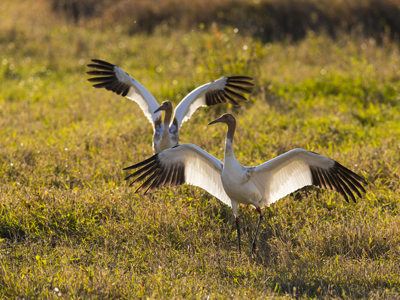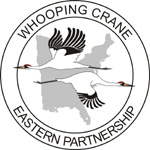| Media Contact: Joan Garland, ICF Outreach Coordinator, 608-381-1262 Curious about the fall Whooping Crane migration? Join Joan for a presentation on current Whooping Crane conservation efforts at 6 pm on Wednesday, November 20 at the Wild Birds Unlimited in Middleton, WI (8402 Old Sauk Rd). Nineteen young Whooping Cranes are winging their way south on their first fall migration. This is the 13th group of birds to take part in the project led by the Whooping Crane Eastern Partnership (WCEP), a coalition of public and private groups that is reintroducing this highly imperiled species in eastern North America, part of its historic range. Nine of the 20 cranes were released October 24 at Horicon National Wildlife Refuge (NWR) in Dodge County, Wis. (below). The chicks were hatched and raised by costumed biologists with project partner International Crane Foundation. The juvenile cranes were released using the Direct Autumn Release (DAR) method, whereby they are released in the company of older cranes from whom the young birds will learn the migration route south. One of the juvenile cranes was recently found dead. The other eight DAR birds remain in the Horicon area. Eight additional juvenile Whooping Cranes are being led south by WCEP partner Operation Migration’s ultralight aircraft. The cranes left the White River Marsh State Wildlife Area in Green Lake County, Wis. on October 2. The ultralight-led birds are currently in Cumberland County, Ill. Three ultralight aircraft and the juvenile cranes will travel through Illinois, Kentucky, Tennessee, Alabama, and Georgia to reach the birds’ wintering habitat at St. Marks National Wildlife Refuge along Florida’s Gulf Coast. This year, in addition to the DAR and ultralight-led release methods, WCEP is testing a new experimental release method referred to as parent-rearing. Four Whooping Crane chicks were hatched and raised by captive adult Whooping Cranes at the U.S. Geological Survey’s Patuxent Wildlife Research Center. On September 23-25, the chicks were released individually in the vicinity of adult Whooping Cranes on Necedah NWR in Juneau County, Wis. Two of the chicks unfortunately died prior to migration. One of the two surviving birds is currently migrating in LaPorte County, Ind., and the other juvenile crane is in Hopkins County, Ky. WCEP is hoping that the parent-rearing method may help answer questions about behaviors learned from other cranes, which may be important to survival and reproduction. While this release method has been used with non-migratory Mississippi Sandhill Cranes and Whooping Cranes in Florida, this is the first time it is being tested with a migratory population. The parent-reared, ultralight-led and DAR chicks are joining a wild-hatched chick, #W3-13, in the 2013 cohort. Number W3-13 and her parents are currently in Woodford County, Ill. To date, six wild-hatched Whooping Crane chicks have fledged in this population. Whooping Cranes were on the verge of extinction in the 1940s. Today, there are only about 600 birds in existence, approximately 445 of them in the wild. Aside from the 109 birds in the WCEP population, the only other migratory population of Whooping Cranes nests at Wood Buffalo National Park in northern Alberta, Canada and winters at Aransas NWR on the Texas Gulf Coast. A non-migratory flock of approximately 20 birds lives year-round in the central Florida Kissimmee region, and an additional 25 non-migratory cranes live in southern Louisiana. WCEP asks anyone who encounters a Whooping Crane in the wild to please give them the respect and distance they need. Do not approach birds on foot within 200 yards; remain in your vehicle; do not approach in a vehicle any closer than 100 yards. Also, please remain concealed and do not speak loudly enough that the birds can hear you. Finally, do not trespass on private property in an attempt to view or photograph Whooping Cranes. Whooping Crane Eastern Partnership founding members are the International Crane Foundation, Operation Migration, Inc., Wisconsin Department of Natural Resources, U.S. Fish and Wildlife Service, the U.S. Geological Survey’s Patuxent Wildlife Research Center and National Wildlife Health Center, the National Fish and Wildlife Foundation, the Natural Resources Foundation of Wisconsin, and the International Whooping Crane Recovery Team. Many other flyway states, provinces, private individuals and conservation groups have joined forces with and support WCEP by donating resources, funding and personnel. More than 60 percent of the project’s budget comes from private sources in the form of grants, public donations and corporate sponsors. | 
Share this video with your friends and help us spread the word that disturbing, harassing or killing Whooping Cranes is a crime.
Make a gift to support Whooping Crane conservation. |



